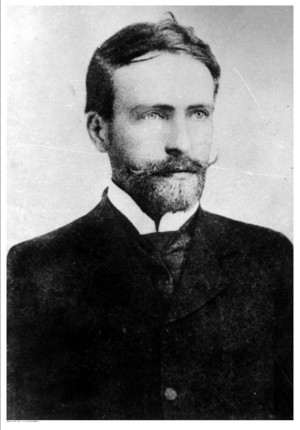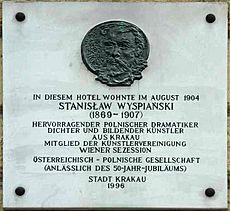Stanisław Wyspiański facts for kids
Quick facts for kids
Stanisław Wyspiański
|
|
|---|---|
 |
|
| Born |
Stanisław Mateusz Ignacy Wyspiański
15 January 1869 |
| Died | 28 November 1907 (aged 38) Kraków, Austrian Poland
|
| Nationality | Polish |
| Education | School of Fine Arts, Kraków |
| Known for | Architecture, drawing, furniture, painting |
| Movement | Art Nouveau, symbolism |
| Spouse(s) | Teodora Teofila Wyspiańska |
Stanisław Mateusz Ignacy Wyspiański (born January 15, 1869 – died November 28, 1907) was a very talented Polish artist. He was a playwright (someone who writes plays), a painter, and a poet. He also designed interiors and furniture.
Wyspiański was a very patriotic writer. He created many symbolic plays about Poland's history and spirit. He was part of an art movement called Young Poland. This movement focused on new ideas in art and literature. Wyspiański was one of the most important artists in Poland during a difficult time. Poland was divided by other countries then. He mixed new art styles like modernism with Polish folk traditions and Romantic history. People sometimes called him the "Fourth Polish Bard." This was a special title given to great Polish poets.
Contents
Life Story of Stanisław Wyspiański
Stanisław Wyspiański was born in Kraków, Poland. His father, Franciszek Wyspiański, was a sculptor. He had a workshop near Wawel Hill. Stanisław's mother, Maria Rogowska, died when he was only seven years old. His father could not take care of him well. So, Stanisław was adopted by his aunt Joanna Stankiewiczowa and her husband Kazimierz.
Early Life and Education
The Stankiewicz family was well-educated and important in society. In their home, Wyspiański met the famous painter Jan Matejko. Matejko often visited their house. He quickly saw that young Stanisław had a special talent for art. Matejko even gave him his first art lessons.
Wyspiański went to Saint Anne's secondary school. This school was special for a few reasons.
- Even though the Polish language was forbidden, lessons were taught in Polish.
- Teachers wanted students to learn a lot about Polish history and literature.
- Many students from this school became important cultural figures in Kraków.
As a student, Wyspiański loved art and literature. His aunt said he drew small houses, animals, plants, and decorations. He even created a play based on Matejko's painting Stefan Batory pod Pskowem.
University and Art Training
In 1887, Wyspiański started studying at Jagiellonian University. He also joined the School of Fine Arts in Kraków. At the university, he took classes in art, history, and literature. Jan Matejko was the head of the School of Fine Arts. He saw Wyspiański's talent and asked him to help paint the inside of the Mariacki Church. This kind of painting is called a polychrome.
Travels and New Ideas
From 1890 to 1895, Wyspiański traveled a lot. He visited Italy, Switzerland, Germany, Prague, and France. His time in France was very important for his art. He studied at a private art school called Académie Colarossi. It was expensive, so he applied for a grant to help pay for it.
In France, he met the artist Paul Gauguin. They visited art museums together. Wyspiański was especially amazed by the paintings of Pierre Puvis de Chavannes. He also watched many plays by William Shakespeare and ancient Greek plays. These plays inspired his own future dramas. These included Daniel i Meleager and Powrót Odysa.
While traveling, he worked on several plays. These were Królowa Polskiej Korony, Warszawianka, and an early version of Legenda. The play Legenda was based on a famous Polish story about Wars and Sawa.
Return to Kraków and Modern Art
In August 1894, Wyspiański returned to Kraków. He quickly became involved in the modern art movement. He designed and partly created a polychrome for the Franciscan Church. This artwork used flowery, geometric, and traditional Polish designs.
The church leader also asked Wyspiański to design stained glass windows. Some famous ones are Blessed Salomea, Saint Francis Stigmata, and God the Father. Wyspiański also won an award for his painting of the Kościuszko Mound.
Theatre Work and Success
Wyspiański worked with the Municipal Theatre in Kraków. He designed furniture and scenography (stage sets) for plays. Later, he even directed some of his own dramas there.
He also worked with the Kraków Society of Friends of Fine Art. In 1898, he became the art manager for a weekly magazine called Życie (Life). His first published plays, Legenda (1897) and Daniel i Meleager (1898), were not very popular.
However, his play Warszawianka brought him immediate fame. Its premiere in 1901 was his official debut as a writer of national plays. The famous actress Helena Modjeska starred in it.
In 1900, Wyspiański married Teodora Pytko, who was the mother of his four children. In November of that year, he attended his friend Lucjan Rydel's wedding. This wedding took place in Bronowice, a village near Kraków. The wedding party inspired his most famous play, Wesele (The Wedding).
The Wedding was a critical and sometimes funny look at Polish society in the 19th century. It showed a society that felt powerless. Even though the government tried to stop its sale, the play was still performed in the theatre. This play made Wyspiański a very important national artist.
Later Works and Final Years
After the success of Wesele (The Wedding), Wyspiański published four more plays about Polish history. These were Wyzwolenie, Achilles, Bolesław Śmiały, and Legenda II. He also published Skałka and Powrót Odysa. He even translated plays by famous writers like Pierre Corneille and Voltaire.
In 1906, Wyspiański became a professor at the Jan Matejko Academy of Fine Arts in Kraków. He was also a member of the city council.
In his last years, Wyspiański's health became very poor. He received medical treatments and then lived in a small house in the village of Węgrzce. He died on November 28, 1907. His funeral in Kraków was a national day of mourning. Wyspiański was buried in the Crypt of the Distinguished in the Skałka Church.
Wyspiański's Artworks
Wyspiański's art was very diverse. He created plays and poems. He also made many drawings, paintings, and designs. These included:
- Views of Kraków (drawings, sketches, oil paintings, pastel drawings).
- Portraits and self-portraits.
- Designs for stained glass windows and paintings.
- Illustrations and graphic art.
- Designs for furniture and interiors.
- Plans for developing Wawel Hill.
Drawings and Pastel Paintings
Some of Wyspiański's most famous works are his drawings. These include his 1890 self-portrait and sketches from his travels. He also created a book of plant drawings, like a herbarium.
He often used soft pastel colors in his art. His first pastel drawings were made between 1890 and 1894. They mostly showed his family, friends, and other artists. Wyspiański loved to draw his children in everyday moments. For example, he drew them sleeping or eating.
- Helenka (1900), a pastel drawing, is at the National Museum, Kraków.
- Śpiący Staś (Sleeping Staś) (1902), a pastel drawing, is at the Silesian Museum in Katowice.
- Śpiący Mietek (Sleeping Mietek) (1904), a pastel drawing, is at the Museum of Art in Łódź.
- Macierzyństwo (Motherhood) (1905), a pastel drawing, is at the National Museum in Kraków.
- Żona artysty z synkiem Stasiem (The Artist's Wife with Their Son Staś) (1904), a pastel drawing, is at the Upper Silesian Museum in Bytom.
He also painted many people he knew using pastels. These included artists like Jacek Malczewski and Jan Stanisławski. He painted landscapes of Kraków, such as the Kraków Planty Park and the Rudawa River. Towards the end of his life, he painted views of the Kościuszko Mound from his studio. He also designed a poster for a play called Wnętrze.
Designs and Architecture
A big part of Wyspiański's work involved designs. He created many stained glass windows, polychromes, and interior designs.
Stanisław Wyspiański and Józef Mehoffer designed 36 stained glass windows together. These were for the Mariacki Church in Kraków. They helped Jan Matejko with the church's restoration. While in Paris, they also designed two boxes for a competition in Prague. They also created curtain designs for the Juliusz Słowacki Theatre in Kraków.
Wyspiański also designed stained glass windows and polychromes for the Franciscan Church in Kraków. This church has his famous stained glass window called Stań się. He designed windows showing Saint Stanislaus, Kazimierz the Great, and Henryk Pobożny for Wawel Cathedral. These were not made until 2005–2007 and are now in the Wyspiański 2000 Pavilion.
In 1905, Wyspiański and Władysław Ekielski planned a big project. They designed a new layout for Wawel Hill, calling it the Acropolis.
Important Stage Plays
Here are some of Stanisław Wyspiański's most important plays:
- Warszawianka (1898)
- Klątwa (The Curse) (1899)
- Protesilas i Leodamia (1899)
- Meleager (1899)
- Legion (1900)
- Wesele (The Wedding) (1901)
- Wyzwolenie (Liberation) (1903)
- Noc listopadowa (November Night) (1904)
- Acropolis (1904)
- Skałka (1907)
- Powrót Odysa (Return of Odysseus) (1907)
Museums and Monuments
There is a Stanisław Wyspiański Museum in Kraków. It is located in the Szołayski tenement house, which is a very old building. This museum is part of the National Museum, Kraków.
At All Saints' Square, there is a special building called the Wyspiański 2000 Information Exhibition Pavilion. It shows three of Wyspiański's stained glass windows. This building is a rare example of modern architecture in the old part of the city.
In 1996, a special plaque was put up in Vienna, Austria. It is at the Austria Classic Hotel Wien. This plaque remembers Wyspiański's frequent stays at the hotel. He even wrote part of a play there in 1904.
In front of the new National Museum building in Kraków, there is a monument to Stanisław Wyspiański. In 2007, the Polish Parliament declared it the Year of Stanisław Wyspiański. This showed how important he was to Poland.
Images for kids
See also
 In Spanish: Stanisław Wyspiański para niños
In Spanish: Stanisław Wyspiański para niños











